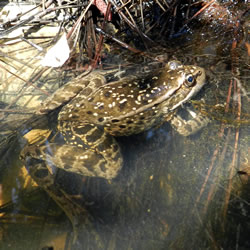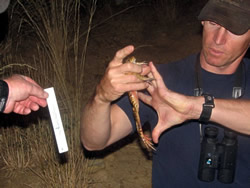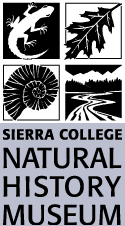California Red-Legged Frog
Joe Medeiros
Professor Emeritus, Botany, Sierra College
Some would argue about choosing this wonderful animal as the official California state amphibian, but its recognition comes just in time for this very rare and endangered frog – its populations have probably been reduced by more than 90%.

Our California red-legged frog (Rana draytonii) once flourished in wetlands along the entire California coastline and into northern Baja California, Mexico. Its Sierran populations stretched the entire length of the Sierra Nevada, but only in the foothills. It is essentially endemic (restricted) to California, excepting for dwindling (and perhaps non-existent) Baja California populations.
This big frog (females are larger and they can get to 5 ½ inches long) was once the largest frog in the west. Historically abundant in numbers it is thought that fewer than 10,000 now exist statewide. Once the largest frog in the West, it is now superseded by the American bullfrog, an introduced interloper. Hopefully, state and federal protection status will enable us to rescue our state symbol from the brink of extinction.
Bullfrogs Were Introduced to California
Before the bullfrog was introduced into California (late 1800s) our red-legged frog was quite popular – too popular for its own good, unfortunately. During the gold rush, it is estimated that as many as 80,000 frogs were annually devoured by miners alone! Eventually, with their populations dwindling, the bullfrog became the “grenouille du jour.” Instead of the bullfrog, it was our red-legged frog that Samuel Clemens (Mark Twain) made famous in The Celebrated Frog of Calaveras County. Today, champions at the annual event are mostly bullfrogs. The rarer red-legged frogs are actually prohibited from the competition.
Like most amphibians of the world, water is a critical element in the frog life cycle. Without copulatory organs, the males must entice the females to “come closer, my dear.” Their vocalizations (croak, ribbit, etc.) are created to court females. If she is interested, the female will swim over to the male for a closer inspection. If all goes well, the male will mount the female from behind and give her a good frog-hug.  Called amplexus, this embrace stimulates the female to release eggs into the water upon which the male will release his sperm. She will then arrange the fertilized eggs and attach them to something at or near the surface (often emergent vegetation). Newly hatched tadpoles resemble fish and eat algae, diatoms and microscopic invertebrates. As they grow, so does their range of food. They eat increasingly larger items until, as adults, they’ll eat anything they can get into their mouths (tree frogs, fish, small mice, etc.). As adults, their natural predators include large birds (egrets, herons, bitterns), aquatic snakes and probably numerous mammals.
Called amplexus, this embrace stimulates the female to release eggs into the water upon which the male will release his sperm. She will then arrange the fertilized eggs and attach them to something at or near the surface (often emergent vegetation). Newly hatched tadpoles resemble fish and eat algae, diatoms and microscopic invertebrates. As they grow, so does their range of food. They eat increasingly larger items until, as adults, they’ll eat anything they can get into their mouths (tree frogs, fish, small mice, etc.). As adults, their natural predators include large birds (egrets, herons, bitterns), aquatic snakes and probably numerous mammals.
Water and wetlands are critical to all amphibians, and our California red-legged frog is no exception. They are truly aquatic, spending much if not most of their time in or near water. They are associated with slow-moving waterways: ponds, lakes, marshes and other slow-water ecosystems. They were historically also found near quieter streams, dispersing into moist forests or woodlands in search of new habitats.
Declining Populations
As California increased in population and natural lands were converted, red-legged frog populations continued to decline.
Habitat alteration or destruction, wetland drainage, water pollution, and urban sprawl have taken a toll on this once-common frog. Now fragmented by large and lengthy gaps, the historic distribution of this species is in serious trouble. Federally listed (United States Fish and Wildlife Service and the Endangered Species Act) as “Threatened” in 1996, our frog is also listed as “Vulnerable” by the IUCN (International Union for Conservation of Nature and Natural Resources) and is a “Species of Special Concern” for the California State Department of Fish and Wildlife.
After years of contentious litigation (mostly brought forth by California home builders organizations), the USFWS finally designated more than 1.6 million acres as “critical habitat” – essentially wherever there are known populations of our frog in the state of California (this is much less than the 4 million acres that were proposed). While this sounds like good news, our frog’s future is far from “out of the woods.” Lots of things must occur for the species to recover:
- We must be educated to identify the species and its habitats when we see them
- We must hope that known populations are not negatively affected (intentionally as well as unintentionally)
- We must purchase, ease, or otherwise protect as many remaining populations as possible
- We must restore or create habitat that will be protected and managed in perpetuity
- We must continue to survey and monitor populations and continue researching the species
- We must reestablish populations in the historic range where now absent
While much of the remaining coastal populations are within government-managed lands (US Forest Service), few of the Sierran populations enjoy such protection. Fortunately, the largest remaining population in the Sierra Nevada is, in fact, protected by conservation easement and managed by a land trust.
Tough Future Ahead
 Our beautiful, native frogs face a tough future. In addition to natural predation and natural drought, they must resist being consumed by bullfrogs, infected by introduced diseases or killed by pollution, insecticides and pesticides.
Our beautiful, native frogs face a tough future. In addition to natural predation and natural drought, they must resist being consumed by bullfrogs, infected by introduced diseases or killed by pollution, insecticides and pesticides.
The California red-legged frog can thank many humans for rescuing it from certain extinction, from individual researchers to government and non-government organizations. But a heart-warming story began in Imperial County. The Sea View Elementary School in Salton Sea, California decided to get serious about a vanishing species that never even came close to where they lived. Ms. Haddad’s after-school club made up of mostly fifth graders decided that they would drill down on a project: to make the rare California red-legged frog the state’s amphibian. Their teacher connected the class with the Bay Area’s “Save the Frogs” conservation organization and they began to research the frogs and the issues. The students then petitioned their state Assemblyman, Manuel Perez who was impressed with their serious and professional efforts. He drafted and carried the bill forward.
In June of 2014, Governor Jerry Brown signed AB 2364 declaring the California red-legged frog as the official state amphibian. The young and passionate students of Sea View Elementary had successfully elevated Mark Twain’s Dan’l Webster to California State Symbol status! And guess what the new mascot name is for the school?
Some General California Red-Legged Frog References
- California Department of Fish and Wildlife
https://nrm.dfg.ca.gov/FileHandler.ashx?DocumentID=7103 - Center for Biological Diversity
http://www.biologicaldiversity.org/species/amphibians/California_red-legged_frog/ - Golden Gate National Parks Conservancy
http://www.parksconservancy.org/conservation/plants-animals/endangered-species/red-legged-frog.html?referrer=https://www.google.com/ - Sierra Forest Legacy
- Wikipedia
https://en.wikipedia.org/wiki/California_red-legged_frog - Photos from Placer Land Trust
